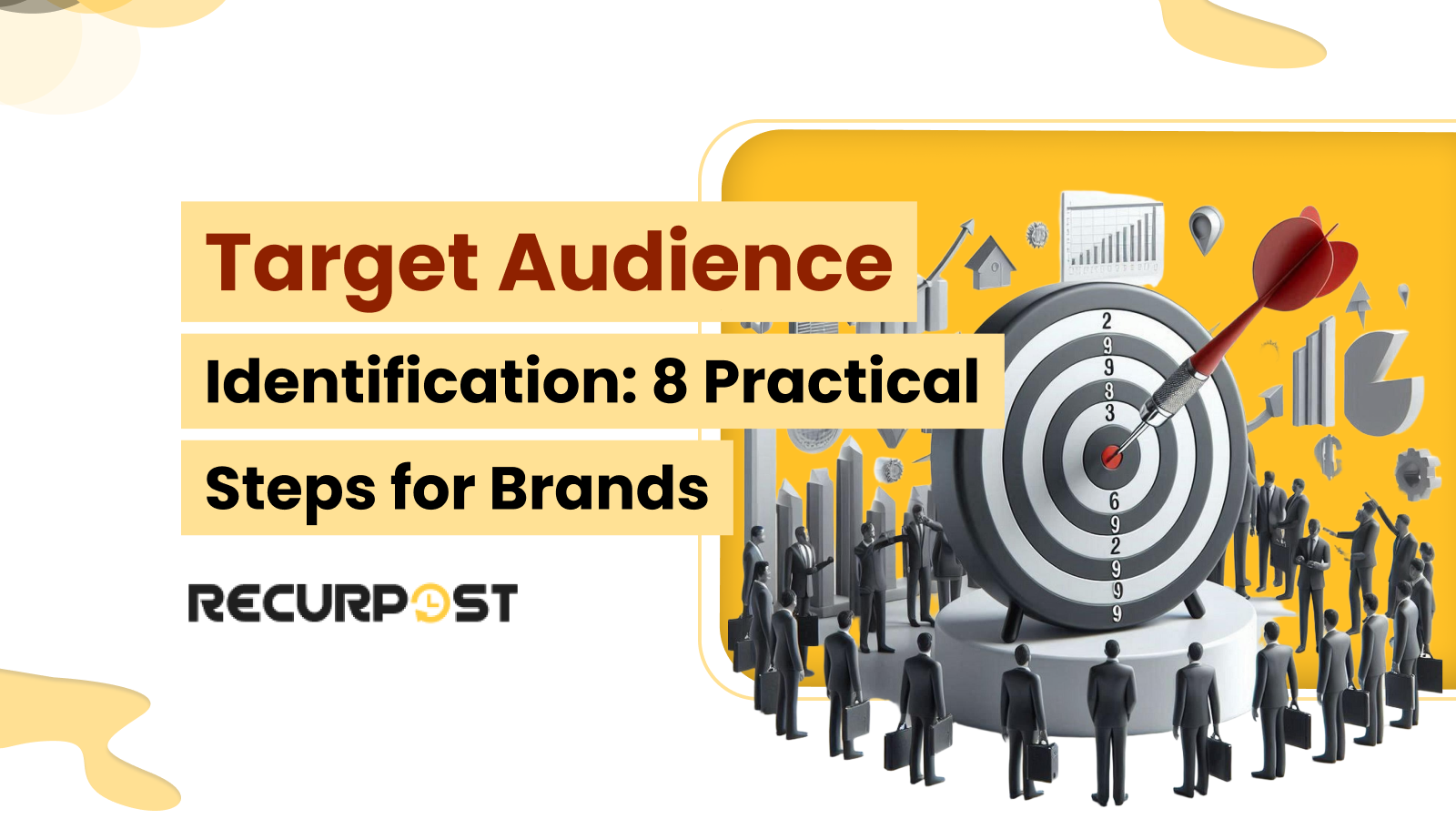You’ve created the perfect product. Your marketing copy is compelling. Your website looks professional. But your sales trickle rather than flow. Sound familiar?
The problem isn’t your product or your marketing skills. The problem is simpler and more basic: you’re talking to the wrong people. Something is missing in your target market research.
Finding your target audience resembles a conversation at a crowded party. When you speak to everyone at once, your voice fades into the noise. When you focus on the right person who truly wants your offer, you capture full attention.
This is exactly what happened to Dollar Shave Club. Rather than compete with Gillette for everyone who shaves, they targeted one group: men fed up with overpriced razors who liked humor and convenience. That narrow focus helped them build a billion-dollar company.
While many methods exist to find a specific target audience, this practical guide lists 8 audience targeting strategies to help you find your ideal customers who genuinely need your product or service. Each method is a step businesses can apply to identify their target audience through customer profiling, data analysis, and market observation.
Whether you’re launching a new brand or refining your marketing, these methods will help you identify, know, and connect with your ideal target audience. These tactics work for B2C and B2B businesses.
Why Most Businesses Get Target Audiences Wrong
Building a target audience profile requires grasping consumer psychology. Many businesses make one mistake: they confuse “people who might buy” with “people who will buy”.
Here’s the difference. Imagine selling premium yoga mats. The product could attract “anyone who exercises” or “anyone into wellness”, but casting such a wide net weakens marketing.
That equals millions of people with no clarity. Speaking to everyone means connecting with no one. Success comes from narrowing who needs your product, why they need it, and where to reach them.
Instead of “anyone who exercises”, think:
Yoga practitioners who train 3+ times weekly, value comfort and alignment, can sense mat quality, and pay more for durability.
That defines a buyer persona within a clear customer segment, not just a vague group.
Knowing exactly who you’re addressing allows audience identification across platforms, content, and products. Though this narrows its reach to thousands rather than millions, these people are ready to purchase.
Precision drives results. Being clear about who you serve makes each part of your marketing effort stronger.
Your ideal customers don’t wear badges. They appear across market segments, blend into various online spaces, and look like others but behave differently. Finding them requires a structured method.
These 8 methods reveal puzzle pieces that, combined, create full customer profiles showing who your prospective customers are.
Start With the Existing Customers’ Behavior
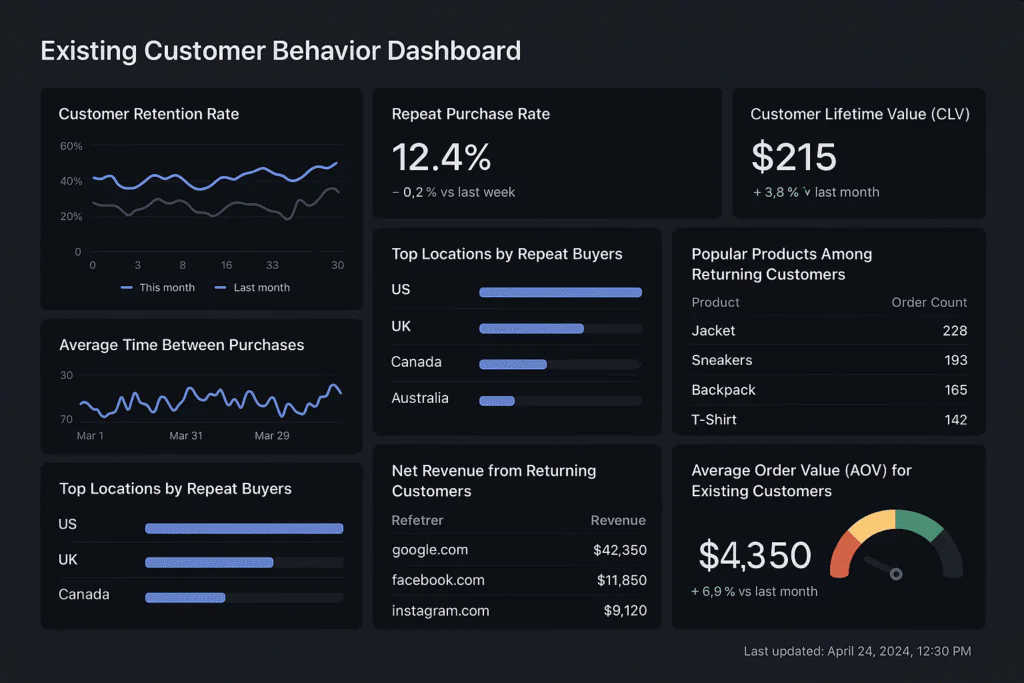
Your existing customer behavior offers the best lessons. They’ve already shown willingness to pay, proving they represent your brand’s target audience in practice.
Look past surface demographics to grasp purchase patterns, motivations, and decision-making styles, which reveal more useful insights.
Collect details from your current customer base:
Purchase patterns
When do customers buy? How often? What sparks decisions? A software company might see buyers convert after 14 days on a free version, signaling optimal outreach timing.
Problem-solving behavior
Pinpoint the problems customers aimed to fix when finding your brand and how they managed before. Did they use rivals’ products, DIY fixes, or nothing at all? These insights clarify your value proposition and show pain points your service addresses.
Discovery paths
Learn how buyers found you: social media, search, referrals, or events. This reveals where your ideal target audience spends time and which channels they trust. This knowledge strengthens marketing by showing where audience targeting works best.
Use analytics for data gathering. Google Analytics displays site behavior. Your CRM records purchase histories and interactions. Service logs expose common customer profiling questions and concerns. Look for repeating signals beyond raw data. Studying 50–100 customers reveals traits that appear again and again. These shared traits form the base for identifying others across customer segments with similar behaviors.
Build Detailed Customer Profiles
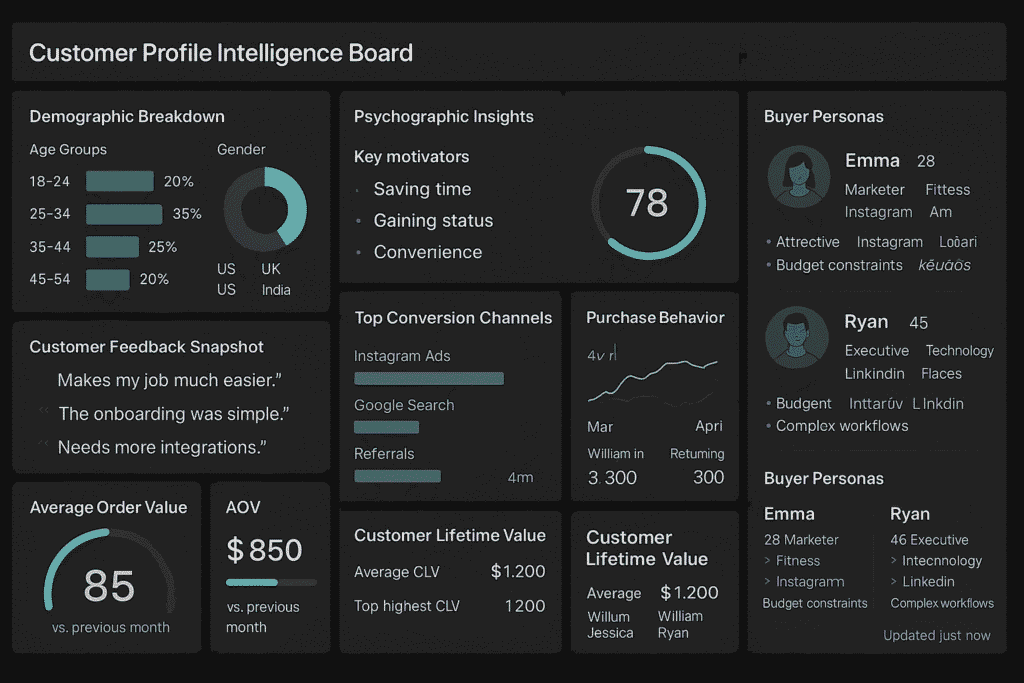
After grasping existing customers, create detailed customer profiles of ideal prospects. Build character profiles that mirror thousands of real people.
Businesses often build overly broad profiles. Describing your target audience as “small business owners aged 25–45” lacks insight. Strong profiles combine demographics with psychographics to reveal who customers are and why they purchase. Well-structured audience examples show what useful profiles contain.
A complete profile covers:
Demographics data
Age, location, income, and job title. Collect details relevant to your business. B2B software firms need job titles and company sizes to target their audience segments. Local restaurants need neighborhood information and dining habits.
Motivations in the decision-making process
Define what drives purchases. Do buyers seek time savings, improved image, security, or social status? A productivity app may attract executives chasing efficiency and parents seeking order, the same product but different motivations.
Information consumption habits
Knowing where prospects seek advice or recommendations helps you reach them better. If they prefer blogs, podcasts, or social media, you can appear in those channels with tailored messages in the right format.
Buying behavior
Consumer behavior insights refine your sales plan. Do buyers research for weeks or purchase on impulse? Do they need approval from others or decide alone? Recognizing this aligns your offer with their decision-making process, boosting the chance of a sale.
Detailed customer profiles reveal what drives your target audience: their motivations, habits, and buying behavior. The right target audience appears when profiles uncover needs, pain points, and behaviors matching what your product or service solves.
Study Your Competitors’ Audiences
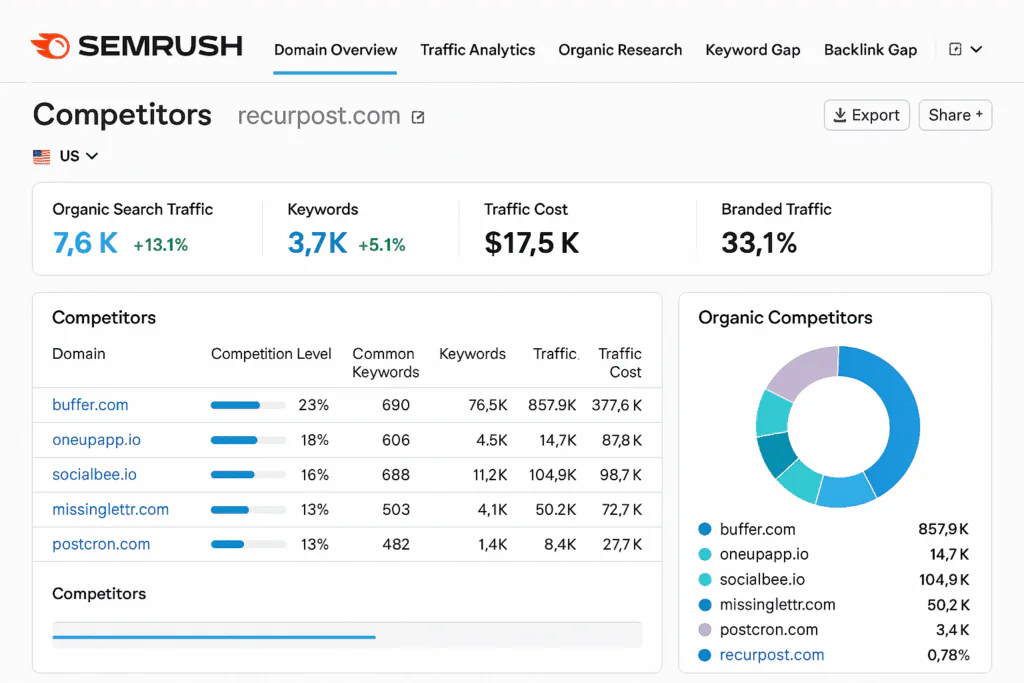
Your competitors already invest resources into competitor audience analysis, showing who buys products like yours. Their target audiences become visible through social media audits, tools like SimilarWeb and SEMrush, and engagement patterns that reveal which market segments respond to similar offers. This shortens months of research and exposes missed opportunities.
This isn’t copying them, but mapping the broader field of people drawn to your category. This target market insight reveals openings.
Start with a social media review. See who follows rivals, who interacts with their posts, and which content sparks responses. Comments often show the target audience’s pain points, questions, and the language and tone your shared base uses.
Next, study their site traffic and content themes. Tools like SimilarWeb and SEMrush display competitor demographics, interests, and behavior trends. This shows not only who their customers are, but how they think and what they value.
Look for these signals:
Engagement patterns
Spot which competitor posts get the most likes, shares, and comments. This reveals content that connects. A fitness brand may see workout tips perform better than promotions, showing the target audience prefers useful, educational posts over sales pushes.
Community discussions
Study the questions and complaints left in competitor threads. These reveal unmet needs or service gaps, insights you can use to stand apart.
Content themes
Track which topics successful rivals push most. This shows what your target audience refers to and values, helping you align with their interests.
Language and tone
Watch how competitors write, formal or casual, technical or plain. This reveals how your shared base prefers to be addressed. Smart competitor study uncovers customer segments you may miss. You might target small business owners, but find corporate managers buying for different reasons. That’s a new opening to explore.
Listen to Online Conversations
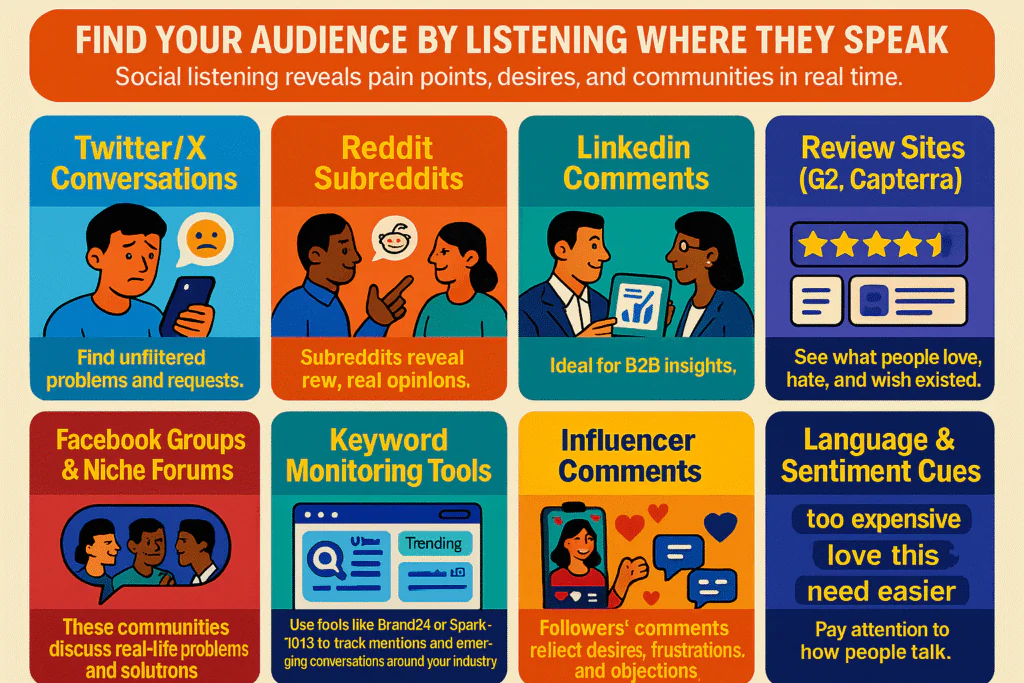
Social listening shows what potential customers think and feel, giving access to thousands of real online conversations about your industry.
Social listening includes monitoring mentions of your brand, competitors, and industry terms across social platforms, forums, and review sites. Its value lies in exposing broader community discussions about the problems your product solves.
Example: if you sell project management software, don’t just monitor mentions of your brand. Track language patterns like “team communication problems,” “missed deadlines,” “project chaos,” and “remote work challenges.” These signal people are already facing the issues you solve.
Where to listen and what to track:
Twitter/X conversations
Search industry pain-point keywords. These platforms reveal target audiences through posts where users share frustrations, ask for advice, or seek fixes. Hashtags, mentions, and niche threads allow precise audience targeting.
Reddit discussions
Subreddits are hubs of genuine talk. Check spaces tied to your industry, roles, or problems. Upvoted threads expose pain points, interests, and opinions, giving insights into what matters most to your target audience.
LinkedIn posts and comments
Vital for B2B. Posts on industry issues and their comment sections expose varied views, lived experiences, and recurring pain points your service can handle.
Review sites and forums
Platforms like G2, Capterra, and niche boards are insight goldmines. Competitor reviews reveal what customers like, dislike, and feel is missing, showing where you can stand apart.
Learn not only what people need but how they describe those needs. Do they call it “team collaboration” or “getting everyone on the same page”? Do they stress efficiency or reduced stress? These language patterns shape messages that truly resonate.
Track Industry Trends and Shifts
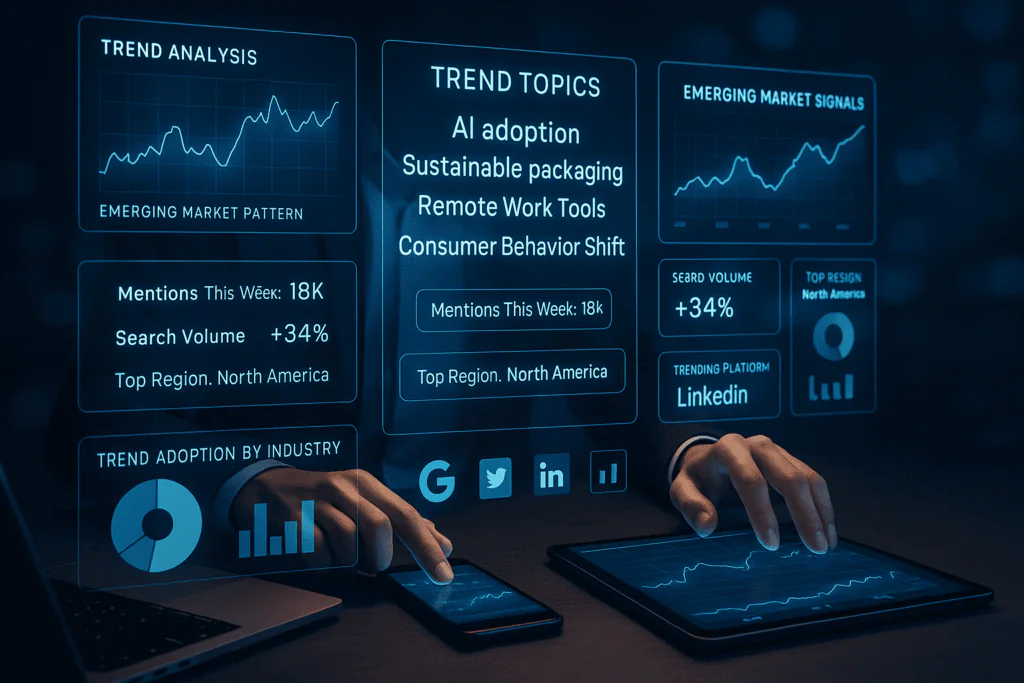
Target audiences shift with evolving industries, new tech, and cultural changes. Spotting industry trends early lets you discover fresh customer segments before rivals.
The pandemic created new market segments overnight. Restaurant owners suddenly needed delivery platforms, teachers needed video conferencing, and fitness instructors turned to online tools. Firms that noticed these emerging needs early captured major market share.
Ways to track and use audience shifts:
Monitor search trends
Tools like Google Trends show what people search for over time. A steady rise in “sustainable packaging” searches may signal a growing target audience of eco-conscious buyers.
Follow industry publications
Trade magazines, blogs, and reports often reveal new challenges and opportunities. These insights help you find new audience segments and adapt to meet changing needs.
Attend virtual conferences and webinars
Speakers share views on rising issues, while the target audience questions in Q&A reveal pain points, concerns, and interests, offering a direct look at what matters most.
Track regulatory changes and technological shifts
New rules, tech, or standards often spark demand. GDPR created a need for compliance tools, while remote work tech fueled demand for collaboration platforms. Staying alert to these shifts helps you serve new demand early.
Connect these trends to specific market segments with specific needs. A “sustainable business practices” trend becomes real when mid-size company marketing managers must report sustainability progress and seek tracking tools. Acting early matters. By the time everyone talks about a trend, the field is saturated. Spotting emerging needs as they form positions you as the clear solution.
Ask Your Audience Directly
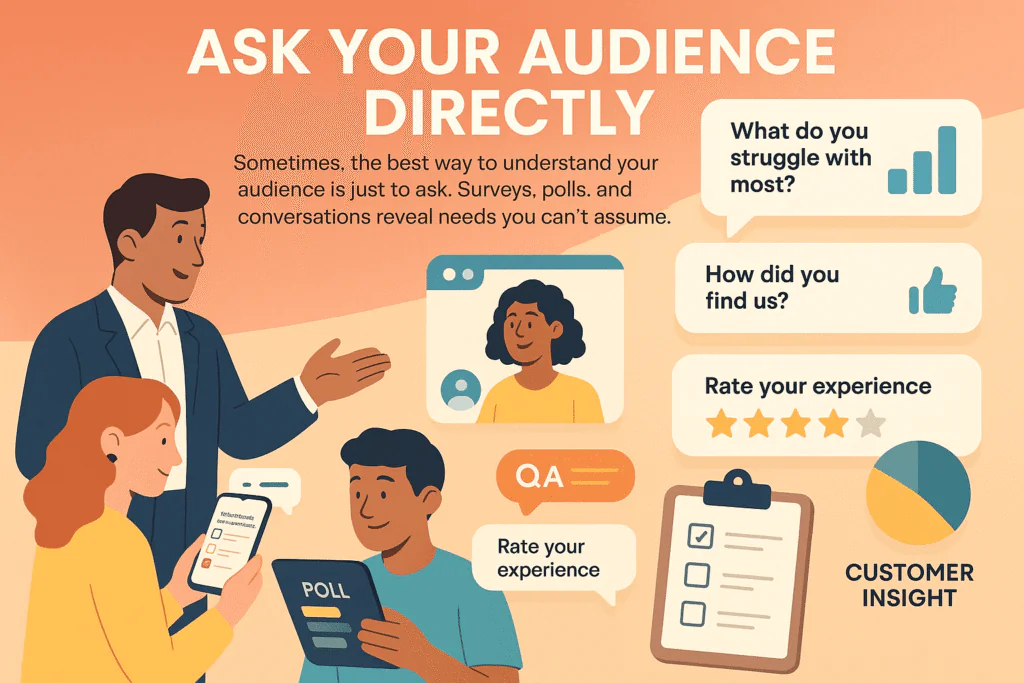
Asking people about their thoughts, feelings, and needs is a strong research method. Customer surveys and customer interviews reveal insights that raw data alone cannot capture.
How you ask shapes what you learn. Generic surveys give generic results. Specific, thoughtful questions expose deeper motivations and the decision-making process that guide marketing.
The most useful questions aren’t about the target audience’s surface preferences. They’re about problems, emotions, and real choices:
Problem-focused questions
“What’s the most frustrating part of [relevant process]?” “What keeps you up at night about [industry challenge]?” “If you could wave a magic wand and fix one thing about [relevant area], what would it be?”
Process questions
“Walk me through the last time you [solved this problem/made this type of purchase/faced this challenge].” “What almost stopped you from [buying/trying/continuing]?” “Who else needs to approve choices like this?”
Language questions
How would you describe this problem to a colleague? What would you Google if you needed a solution? These reveal the exact language patterns your target audience uses, which later guide your marketing copy.
Alternative solutions
How do you currently handle this? What other options did you consider? This shows what you compete against, often outside your category.
For customer interviews, aim for 15–20 talks with a mix of current buyers, prospects, and those who didn’t purchase. The goal isn’t statistical significance; it’s grasping the stories behind the data.
Customer surveys validate these insights. Once interviews reveal patterns, surveys confirm how common those patterns are across your audience.
Explore Online Communities and Forums For a Deeper Understanding
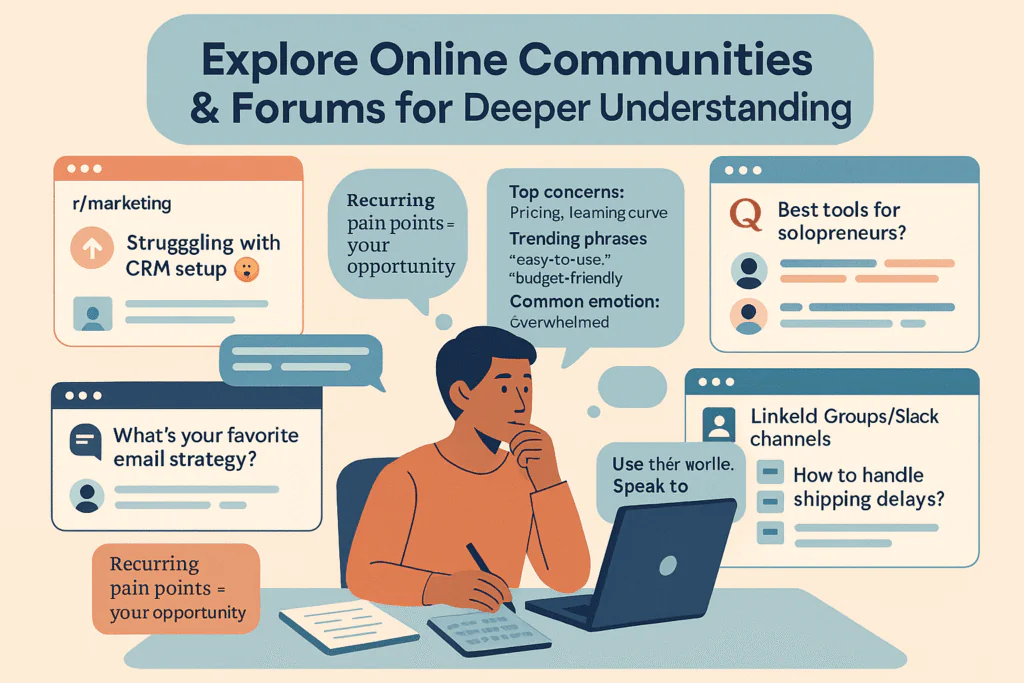
In online communities, buyers share experiences, ask questions, and seek advice. These act as natural focus groups where people speak openly without knowing they’re being observed.
The key is spotting the right forums. Your ideal customers aren’t only in industry groups; they’re also active in spaces tied to roles, challenges, and interests. For instance, if you sell email marketing software, you’ll likely find them in:
- Marketing forums (skill-based)
- Small business owner groups (role-based)
- E-commerce communities (industry-specific)
- Entrepreneur networks (identity-driven)
When exploring these communities, pay close attention to:
Common questions and challenges
Take a look at what people ask about most often. These common questions uncover pain points or unmet needs your product could solve. If the same frustrations repeat, you’ve likely found a new audience targeting chance.
Language and terminology
Note how people describe problems, goals, and frustrations. Their words should guide your messaging. Using their language patterns builds trust and makes your marketing relatable.
Recommended tools and services
Watch for tools, services, or platforms members often recommend. These may be competitors, but also alternatives your target audience already trusts. This insight supports better customer profiling and sharper positioning.
Successes and failures
When users share what worked or failed, you see their decision-making process. You learn what they value, what they avoid, and where other offers fall short, giving you gaps to fill.
Community culture and values
Each community has norms, tone, and community values. Some prefer data-backed advice, others casual talk. Grasping these norms lets you engage naturally without seeming out of place.
Analyze Your Email Subscriber Behavior For Strategic Targeting
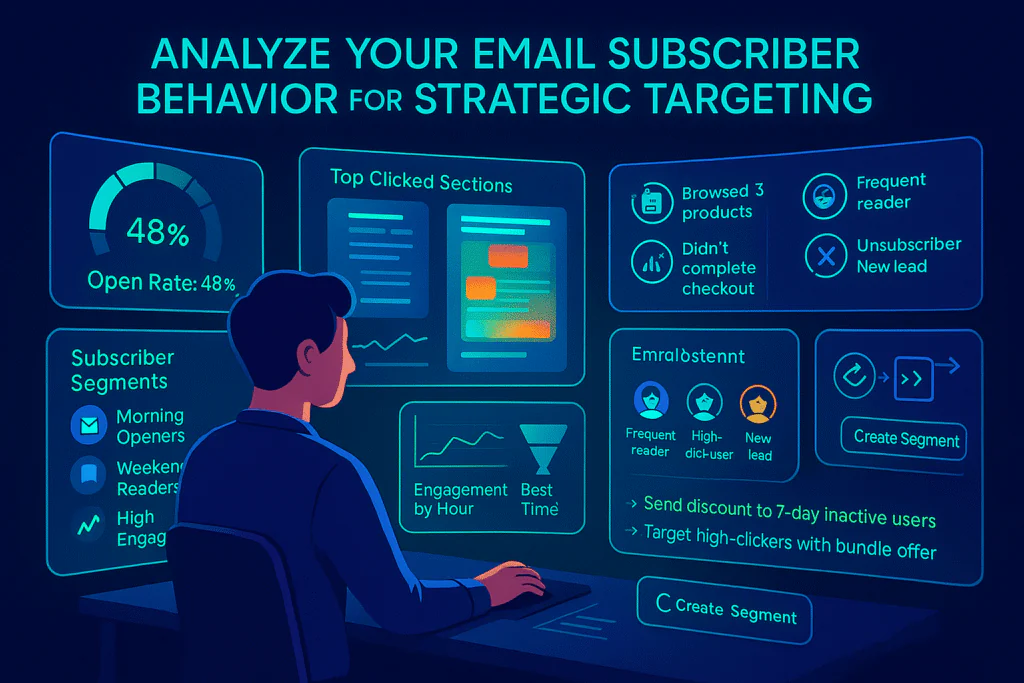
Your email list contains people already showing interest, forming a strong target audience segment. Analyzing email subscriber behavior uncovers distinct groups with different needs, improving customer ties.
Email insights reveal details that other data misses. Two subscribers may share demographics yet show different engagement patterns: one opens every email, another only specific topics. These differences reveal motivations and needs.
Segment your list by:
Engagement levels
Subscribers who open, click, and reply often mirror your ideal buyer. Look deeper: Do they join webinars, post on social channels, or purchase often? These engagement levels connect to a broader engagement rate (15–25%) benchmark.
Studying these signals exposes shared traits and behaviors, helping you build sharper customer profiles.
Content preferences
Which topics earn the highest open or click rates across groups? These content preferences reveal what each segment values most, guiding content analysis.
Timing patterns
When groups engage, show routines and locations. Early opens may point to professionals checking before work, while evening opens may reflect freelancers or global audiences. These timing patterns refine send times and reveal lifestyle habits.
Action patterns
Do some click on learning content while others favor offers? These action patterns show stages in the buyer’s journey and different motivations.
For deeper insights, survey engaged subscribers. They’ve shown interest, so they often share rich customer feedback on needs, challenges, and the decision-making process.
You can also test varied messaging. Send one version stressing time savings, another stressing cost savings, and compare which resonates with each customer segment.
Additional Way to Find Target Audience: Leverage AI
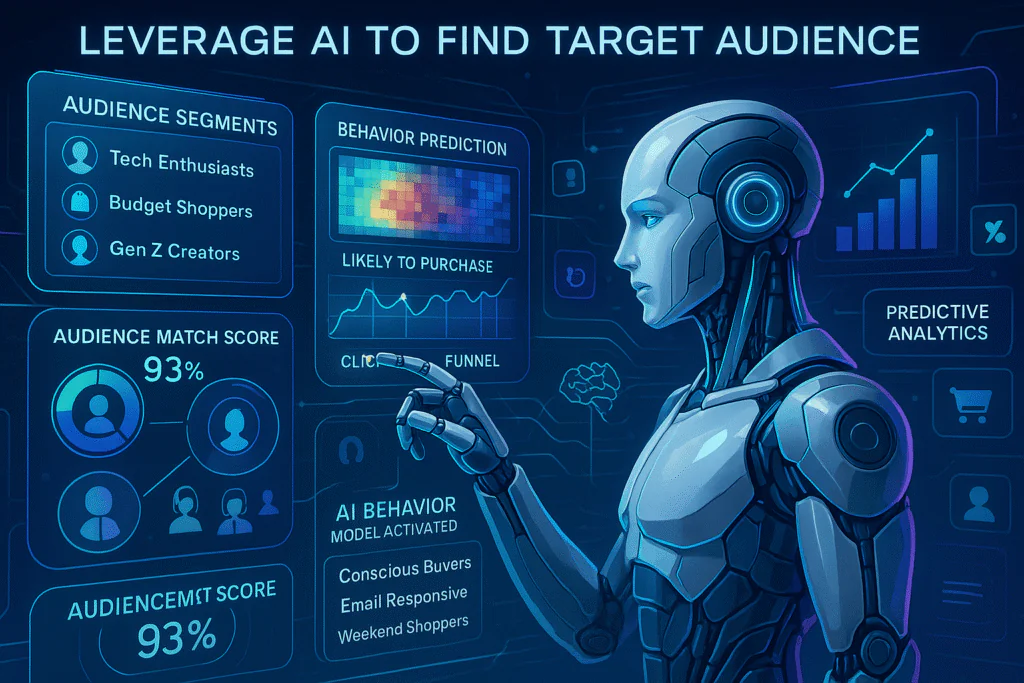
AI and advanced analytics scan large datasets to reveal patterns humans might miss. These audience targeting tools spot hidden links and emerging needs.
Modern AI platforms study customer data analysis, industry trends, social activity, website behavior, and market insights to expose overlooked target audience groups and traits.
Ways to apply AI for research:
Customer data analysis
AI reviews customer databases to uncover hidden customer segments based on purchase habits, behavior, and traits not visible to manual review.
Social media insights
Tools like SparkToro show what your target audience follows, shares, and engages with across platforms, revealing social media insights for sharper targeting.
Content analysis
AI reviews feedback, tickets, and mentions to find shared themes, sentiment, and language patterns.
Predictive modeling
Advanced tools forecast which prospects are most likely to convert based on shared behaviors and attributes.
Competitive intelligence
AI maps competitor audiences at scale, surfacing market segments and gaps you can exploit.
Use AI wisely: ask the right questions and add human judgment. AI finds signals, but you must grasp what those signals mean for your plan. Example: analysis might show your customers are 40% more likely to engage on Tuesday afternoons. That’s interesting, but the insight is that they may be knowledge workers catching up mid-week when their schedules ease.
Putting It All Together for Effective Audience Targeting
Combine these 9 methods with purpose instead of tackling all at once. The audience identification process works like a puzzle: each method adds pieces that, together, create a full picture of your target market.
How to prioritize research:
Start with what you have
Begin with Method 1 (studying existing customers). It’s free and gives instant insights, forming your base for all else.
Add external perspectives
Use competitor analysis and social listening to gain a wider view and spot growth chances or missed customer segments.
Validate with direct research
Apply customer surveys, interviews, and community reviews to confirm hypotheses and grasp the “why” behind observed patterns.
Test and refine
Rely on email analysis and ad testing to confirm insights with real actions and adjust messaging refinement.
Scale with technology
Apply AI and analytics to scan bigger datasets and surface signals across methods.
Aim for actionable insights that make marketing stronger, not flawless data. Look for patterns solid enough for decisions, not academic certainty.
Treat audience research as continuous research, not a one-off task. Audiences evolve, new market segments appear, and conditions shift. Revisit research quarterly and refine insights often.
Use findings for customer journey mapping, channel optimization, product improvement, and sales process alignment. Add personalization so each segment receives content and offers that match its needs.
Businesses that apply these steps create sharper positioning and long-term growth, driven by a well-studied target audience.
Common Mistakes That Waste Time and Money
Even with the right methods, mistakes can lead to misleading results or wasted resources. Here are the most common pitfalls and how to avoid them:
Mistake 1:
Confusing correlation with causation. Just because two traits appear together doesn’t mean one drives the other. Your buyers may all live in cities and hold degrees, but that doesn’t mean location or education drives purchases. This is a case of confusing correlation with causation.
Mistake 2:
Over-relying on demographics. Age, gender, and location are easy to track but often less useful than motivations or the decision-making process. Two managers of the same age may have totally different needs based on role or industry. This is over-reliance on demographics.
Mistake 3:
Assuming loud customers represent everyone. People leaving reviews or posting online may not represent the full base. Quieter groups matter as much. This is assuming loud customers represent everyone.
Mistake 4:
Ignoring non-buyers. Learning why people skipped your product is often more useful than only studying buyers. Those “no” reasons show barriers you must fix. This is ignoring non-buyers.
Mistake 5:
Stopping research after launch. Your first insights are only a start. Continuous research reveals shifts in the target audience and helps you spot openings before rivals do. This is stopping research after launch.
Your Next Steps: From Research to Results
Target audience insights only matter when applied. Here’s how to turn research into action:
- Messaging refinement: Use the language your audience speaks. Replace jargon with words buyers recognize. Address problems they want solved, not just product features.
- Channel optimization: If findings show your audience prefers LinkedIn over Facebook, or podcasts over blogs, shift resources accordingly. Meet them where they already spend time.
- Product improvement: Research often shows unmet needs or frustrations with current solutions. Use these insights to guide updates or new features.
- Personalization: Different customer segments require unique approaches. Build tailored content, offers, and strategies for each.
- Sales process alignment: Grasping how your audience makes choices helps you align the sales journey with their decision path. Add customer feedback loops to improve accuracy and build loyalty. Use insights for customer journey mapping so you can see how prospects move from awareness to purchase.
Businesses that commit to studying their audience win in the long term. They grasp not just what customers buy, but why they buy, how they think, and what drives them most.
Getting Started: Your Target Audience Research Action Plan
To identify target audience segments, begin with one method most relevant to your case. Start with that, gather insights, test in campaigns, and measure results. Then, gradually add other market research methods to broaden and deepen your grasp.
While no perfectly defined target audience exists, better grasping still boosts performance. Each insight improves marketing strength, adds value to products, and increases satisfaction. This is part of continuous research.
Building strong customer relationships also drives growth. Every step toward defining your target audience supports sharper choices and long-term customer loyalty.
Your ideal customers are already searching for your offer, and these proven methods help you connect with them.
Frequently Asked Questions About Finding Your Target Audience
1. How do I find my target audience for free?
Start by analyzing your existing customers using free tools like Google Analytics, social media insights, and customer surveys. Monitor online communities where your potential customers gather, such as Reddit forums, Facebook groups, and industry-specific communities. Use Google Trends to understand search behavior and social listening through free tools like Google Alerts to track conversations about your industry.
2. What is the difference between the target audience and the target market?
Your target market refers to the larger group of individuals who may have an interest in purchasing your product or service. Your target audience is a specific segment within that market that you’re actively trying to reach with your marketing campaigns. For example, your target market might be “small business owners,” while your target audience could be “marketing managers at tech startups with 10-50 employees.”
3. How do I know if I’ve identified the right target audience?
You’ll know you’ve found the right target audience when you see higher engagement rates, better conversion rates, and more qualified leads. Your marketing messages will resonate more strongly, customers will refer others more frequently, and you’ll spend less money acquiring each new customer. Track key metrics like click-through rates, conversion rates, and customer lifetime value to measure success.
4. How often should I research my target audience?
Audience research should be an ongoing process, not a one-time activity. Review your audience data quarterly and conduct comprehensive research annually. Markets evolve, new competitors emerge, and customer preferences change. Set up continuous monitoring through social listening tools and regularly survey your customers to stay current with their needs.
5. Can a business have multiple target audiences?
Yes, most successful businesses serve multiple target audiences or customer segments. However, each audience should have distinct characteristics and receive tailored messaging. For example, a project management software company might target both small business owners and enterprise team managers, but with different marketing approaches for each group.
6. What tools are essential for target audience research?
Essential audience research tools include Google Analytics for website behavior, social media analytics for engagement insights, survey platforms such as Typeform or Google Forms, social listening tools like Hootsuite or Mention, and competitive analysis tools like SEMrush or SimilarWeb. These target audience tools automate data collection and analysis processes that would otherwise require manual research, allowing businesses to gather demographic information, behavioral patterns, and engagement metrics efficiently.

Fenil Patel makes complex topics simple and useful for readers who want clarity, value, and actionable takeaways. As an SEO content writer with 4+ years of experience, he creates blogs and website content that answer real questions, solve problems, and guide readers toward informed decisions. Whether it’s healthcare, fashion, or SaaS, Fenil’s writing is designed to give you practical insights while ensuring the information you read is trustworthy, engaging, and easy to apply.

